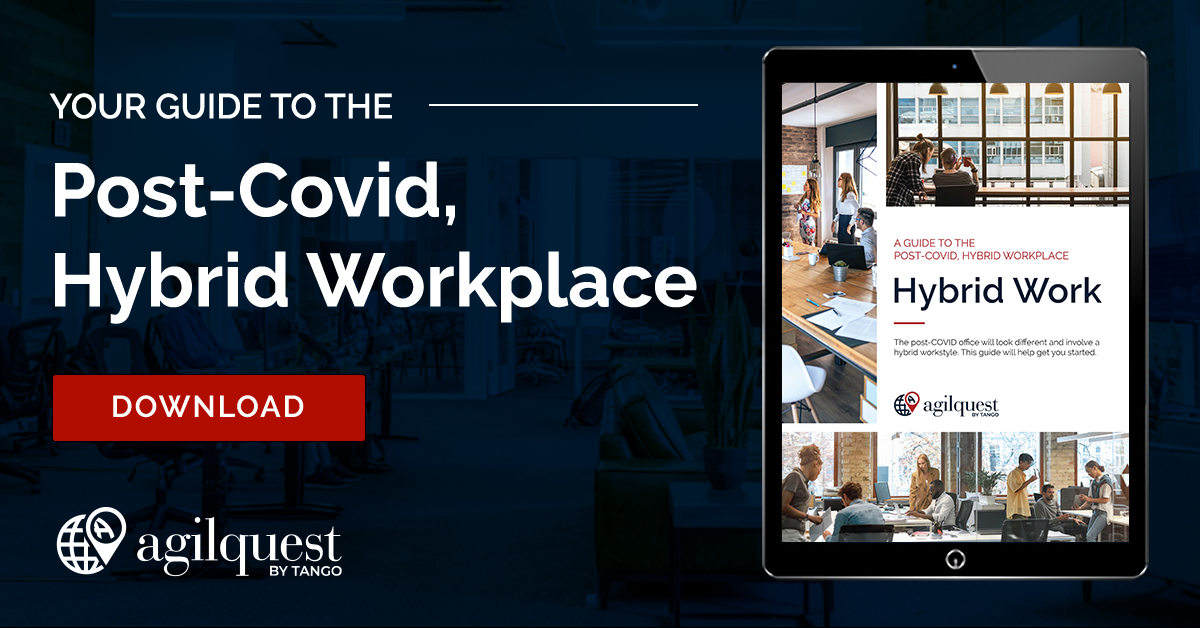How to Support Your Hybrid Workplace
In the last post, we covered how to create a hybrid workplace, what that actually means, and companies that are currently managing a hybrid workplace. The next step is knowing how to support your hybrid workplace by ensuring your company has the right workforce, technology, and space.
The hybrid workplace is a flexible workplace practice that suggests a balance between working in the office and working remotely.
Supporting your hybrid workforce and their physical needs (technology, workspace, etc.) is equally as important as supporting company culture and employee wellbeing (check-ins, wellness programs, etc.)
In this post, we cover the workforce and its physical needs. Our next post in the series goes over ways to reinvent company culture and boost employee morale in your new hybrid workplace.
[Get all of this information and more when you download this guide.]

3 Areas Where Workforce Support Is Needed Most: Communication, Trust, and Middle Management
1. Communication
With your Hybrid Champion Team created and your hybrid workplace planned out, you are ready to communicate the new setup to your workforce. And communicate it again and again.
For a hybrid workplace to be successful everyone needs to know what part they play and what rules they follow. Managers need to be trained on how to successfully manage a hybrid workforce. And employees need to know what is expected of them and who they can communicate with throughout the process.
Documentation and processes will be key to a successful and efficient hybrid workplace. Whether documenting this new process and its guidelines or just making sure meetings are recorded and minutes are taken for those not in the office or not working at that time, documentation will keep everyone in the loop and on the same page as everyone else on the team.
2. Trust
This is THE word that makes the whole hybrid workplace phenomenon work. Without trust, any type of remote work doesn’t work.
It used to be productivity was measured by butts in seats. As long as someone was in the office from 9 to 5 they were doing their job well. Obviously, that doesn’t work anymore. When many of the workforce were moved to their homes because of the 2020 pandemic, productivity had to be measured by what was actually getting done.
And guess what? It worked.

You know why?
Because you hired good, trustworthy people to get the job done. If you can’t trust your employees, you either hired the wrong ones or you have trust issues… If it’s the first option, here’s some tips for hiring better in the future. If it’s the latter, I suggest therapy. Seriously, everyone should go to therapy anyway, it’s great for your mental wellbeing, but I digress!
Trusting your employees is crucial.
With trust as a foundation, your company can offer flexible working options, and with those flex options, employees will enjoy their work and workplace more because of the freedom and choice. When employees are happy, you will see higher productivity. It’s a WIN-WIN-WIN. But only if you trust, and preach trust to management, and show trust in employees.
3. Middle Management
There’s one group of your workforce that needs extra focus and support when creating and implementing your hybrid workplace.
Middle Management Will Be the Most Impacted by the Hybrid Workplace
When a decision like creating and managing a new way of working is made from the top, employees immediately look to their manager for the answers. I can’t imagine many employees will hear of this news and walk straight to the CEOs office to discuss it.
So, middle management needs to be trained and supported to handle this new role. Because in the beginning it is going to feel like a whole new role, on top of everything they are already working on and managing. While the Hybrid Champion Team is in planning mode, they must also plan how to communicate middle management’s new duties, support them in the beginning, and trust them to do their new responsibilities well.
Technology to Support Your Hybrid Workplace
Communication and Accessibility
Everyone needs to be equipped to be successful wherever they are. If your company plans to allow for remote work, then employees need to be set up for remote success. Start by creating a list of home office needs, like a monitor, noise-canceling headphones, internet connection, etc.
If it feels like there is too much to provide, consider creating a stipend for employees to use to cover internet costs, cellular plans, etc. We’ve even heard of companies offering an allowance to employees that bring their own devices (BYOD) as this can help take some work off the IT department.
Then, think about the needs of the organization. To enable employees to easily work wherever they are, you need to have your company set up on a VPN, with cloud filing and storage, and offer video conferencing and communication tools.
It’s all about making in-office and remote work interchangeable. It should be as easy for an employee to work at home as it is to work in the office as it is to work in a coworking site. Making sure necessary equipment is available, documents are easily accessible, quick, and efficient ways to communicate to virtual and in-office coworkers are in place, etc. is a must.
Physical Space Access, Capacity Management, and Reporting
Finally, think about what technology your physical office space needs to support your hybrid workplace. Creating a touchless office experience will make employees feel cleaner and safer. Some companies are using smart building technology that turns lights on when a room is entered and unlocks doors when a badge is swiped.
With the right workplace management software, digital signage can be placed around the office for wayfinding and room availability, and QR Codes can enable employees to claim space right from their phones. Your workplace management software can help you limit office capacity and can be set up to keep workspaces open for a certain amount of time after each use to ensure it is properly cleaned and sanitized before the next reservation. Plus, track the use of space for your cleaning service or for contact tracing when necessary.
[Forum, AgilQuest’s Workplace Management Software, can help you support your hybrid workplace. Learn more about Forum by setting up a demo.]
Reimagining Office Space For Your Hybrid Workforce
On top of the technology your physical office space could use, it’s also time for a makeover. The purpose of the office has changed for everyone. According to a recent PWC survey,
The top 4 Reasons Employees Need the Office Are To:
- Collaborate
- Access equipment or documents securely
- Meet with clients or colleagues
- Training and career development
The Top 4 Reasons Employers Need the Office Are To:
- Increase employee productivity
- Provide space to meet with clients
- Enable employees to collaborate effectively
- Enable company culture
This means the traditional working model where every employee has their own desk is now moving towards activity-based or team/event-based working.
Activity-Based Space
Activity-based working is a flexible practice that offers employees different workspaces and resources to fit the type of work they are doing. Goodbye assigned seating, hello free address. This would mean reworking your office space to include break-out areas, huddle rooms for heads-down teamwork, large café type spaces for creativity and collaboration, neighborhoods of workstations, etc.
Team-/Event-Based Space
Team- or Event-based working is similar to activity-based working but with more emphasis on larger spaces for teamwork or events. In these cases, most individual work would be done remotely while collaboration and meetings would happen in the office.



So, what kind of working space supports your hybrid workforce?
The best way to make sure you are providing the right spaces and resources to the right people is by knowing exactly what they need. I mean, obviously.
But how?
With data.
By implementing a workplace reservation system that manages your workspaces and resources, you can see which spaces get used most often and by whom. Having that information means you can create and optimize a hybrid workplace that works for everyone.
Up Next: Culture and Wellbeing in Your Hybrid Workplace
The hybrid workplace has been around for years, in different forms, shapes, and names. And it will continue to be around for the unforeseeable future. So, don’t rush the process of setting up and supporting a successful hybrid workplace, and remember that you can always change and optimize it as you grow and learn. Next, let’s discuss creating a remote culture that works.
If you have any additional steps or tips to managing an effective hybrid workplace, comment below.
If you’re in charge of the safe return, check out our back to the workplace page and download our guide to the post-COVID, hybrid workplace.

